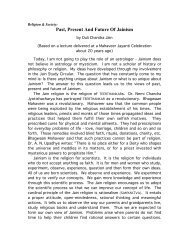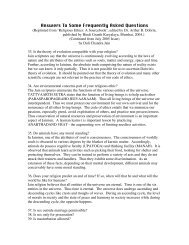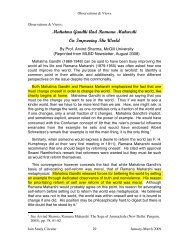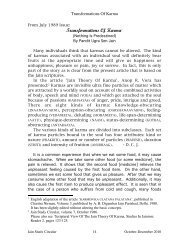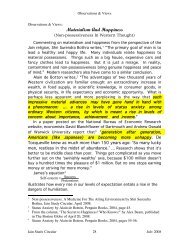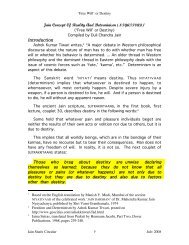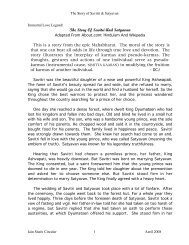Link to Complete Article - The Jain Study Circle
Link to Complete Article - The Jain Study Circle
Link to Complete Article - The Jain Study Circle
Create successful ePaper yourself
Turn your PDF publications into a flip-book with our unique Google optimized e-Paper software.
Selections From Acharya Umasvati’s TATTVAARTH SUTRAmotion, principle of rest and time are the six entities that comprise theuniverse. Each entity possesses certain characteristic attributes and itundergoes transformations according <strong>to</strong> its attributes. <strong>The</strong>se constitutethe laws of nature, which are responsible for the evolution of theuniverse.Attributes of existence:UTPAADAVYAYADHRAUYAYUKTAM SAT [5-30]Attributes of existence are permanence with respect <strong>to</strong> intrinsicattributes, while origination and annihilation with regard <strong>to</strong>modifications.Existence implies permanence with respect <strong>to</strong> intrinsic attributes, and,origination and annihilation with respect <strong>to</strong> modifications. Annihilationimplies destruction of the present state (mode or form) and originationentails the inception of a new state (mode or form). In these processes,the innate characteristics of the substance such as existence and thequality of being substantial remain invariable. This is the aspect ofpermanence. For example, a piece of coal burns and turns in<strong>to</strong> ashes. Inthis process, the lump of coal is depleted and powdered ashes areformed. <strong>The</strong>se constitute annihilation and origination, respectively.However, the element carbon remains permanent.<strong>The</strong> above concept of entity in <strong>Jain</strong> philosophy precludes the need forcreation and Crea<strong>to</strong>r. <strong>The</strong> entities of the universe are eternal andpermanent from the point of view of intrinsic attributes. Thus theycannot be created out of a void. Only transient forms can be created ordestroyed. All entities are eternal. <strong>The</strong>ir quantities remain constant.One entity cannot be changed in<strong>to</strong> another. <strong>The</strong> entities are formlessexcept for matter and energy (PUDGAL). When matter (including energyPUDGAL) interacts with matter, or when soul and matter interact with oneanother, transformations of states take place. This principle ofpermanence of the <strong>Jain</strong> philosophy can be related <strong>to</strong> the law ofindestructibility of matter of modern science as defined in the eighteenthcentury by the famous scientist Lavoisier in the following words: Nothingcan be created and in every process there is just as much substance(quantity of matter) present before and after the process has takenplace. <strong>The</strong>re is only a change or modification of matter.Definition of permanence:TADBHAAVAAVYAYAM NITYAM [5-31]<strong>Jain</strong> <strong>Study</strong> Circular 2July 2008
Selections From Acharya Umasvati’s TATTVAARTH SUTRAPermanence pertains <strong>to</strong> the innate nature (TADBHAAV) of entities,which implies indestructibility of essence and attributes of respectiveentities.<strong>The</strong> universe including all the entities is eternal (everlasting) as far asthe innate nature of the entities is concerned. However, from the poin<strong>to</strong>f view of the continual transformations that occur in the universe, it isevanescent (impermanent). <strong>The</strong>se represent the essential nature of theuniverse. For example consider the forms (various lives) of a soul. Aworldly soul is associated with karmic particles. Thus it undergoesvarious phases in life - indulges in thoughts and emotions. <strong>The</strong> karmicparticles serve as external instrumental causes of these modes.However, even during these modes, the intrinsic nature of the soul -perception, knowledge and bliss, remain intact, although they are latent.When a worldly soul sheds all karmic particles and attains its pristinestate, origination and annihilation continue in its thought-activityaccording <strong>to</strong> its innate nature - absolute perception, knowledge and bliss.Disparate features in an object:ARPITAANARPITASIDDHEH [5-32]Any substance is established by considering its primary (ARPITelemental) characteristics and its secondary (ANARPIT incidental)characteristics.Each and every object or situation can be examined through itsprimary as well as through its secondary characteristics. <strong>The</strong>se analysesmay lead <strong>to</strong> contradic<strong>to</strong>ry conclusions. When water evaporates, theliquid phase is destroyed and gaseous phase is generated. From this(incidental) point of view, water is not indestructible. However, eachmolecule of water consists of two a<strong>to</strong>ms of hydrogen and one a<strong>to</strong>m ofoxygen. This is true in both liquid as well as gaseous phases. From this(elemental) point of view, water is permanent. In this manner, the twocontradic<strong>to</strong>ry views of a given situation can be reconciled.According <strong>to</strong> modern science, there is no magnetic field associatedwith a charge at rest. However, a charge is in motion has a magneticfield associated with it. Thus if a scientist on earth performs anexperiment <strong>to</strong> detect the magnetic field due <strong>to</strong> the charged sphere, theresult will be negative. But the charged sphere on earth is in motionrelative <strong>to</strong> a spacecraft. Thus if an astronaut on the spacecraft performsan experiment <strong>to</strong> detect the magnetic field due <strong>to</strong> the charged sphere,the result will be positive. This indicates that the result of anobservation depends on the viewpoint of the observer. Again, the two<strong>Jain</strong> <strong>Study</strong> Circular 3July 2008
Selections From Acharya Umasvati’s TATTVAARTH SUTRAobservations, which appear <strong>to</strong> be contradic<strong>to</strong>ry on the surface, can beeasily reconciled by considering the two different points of view.Attributes responsible for the formation of aggregates:SNIGDHAROOKSHVAD BANDHAH [5-33]Combination of particles and aggregates is caused on account ofsmooth and rough attributes of <strong>to</strong>uch.All substances in the universe, such as lead, gold and sulfur, which wesee or detect through our senses, are made up of particles possessingsmooth and rough attributes. Further, their constituent particles aresimilar and therefore all matter is identical in nature. Prior <strong>to</strong> the adven<strong>to</strong>f the theory of electronic structure, scientists believed that differentelements were made up of different kinds of matter. However, thetheory of electronic structure has led <strong>to</strong> the conclusion that a<strong>to</strong>ms of allelements are made up of pro<strong>to</strong>ns, neutrons and electrons. Thus allmatter is similar in nature. This scientific fact agrees with the <strong>Jain</strong>concept of matter.Touch is of two kinds: smooth (SNIGDH) and rough (ROOKSH). <strong>The</strong>Sanskrit words SNIGDH and ROOKSH are commonly interpreted as smoothand rough, respectively. However, in SARVAAARTHASIDDHI, AcharyaPujyapad has written:SNIGDHAROOKSHAGUNANIMITTO VIDYUD ...This literally means that lightning occurs on account of the SNIGDH andROOKSH attributes. On this basis, Prof. G. R. <strong>Jain</strong> has identified the SNIGDHand ROOKSH kinds of <strong>to</strong>uch with positive and negative kinds of electricalcharges. 2 Thus SPARSH refers <strong>to</strong> electrical charge. Modern sciencebelieves that lightning and thunder are caused through electricaldischarge. Thus it appears that the words SNIGDH and ROOKSH meanpositive and negative charges, respectively.A rule regarding non-formation of aggregates:NA JAGHANYA GUNAANAAM [5-34]Combination does not take place of particles that possess theminimum (one) unit of smooth or rough attribute.A unit of smooth or rough attribute is indivisible quantity of <strong>to</strong>uch.Particles or aggregates of matter can have one, two, numerable,innumerable or infinite units of smooth or rough attributes of <strong>to</strong>uch.2Cosmology: Old and New by Prof. G. R. <strong>Jain</strong>, published by Bharatiya Jnanapith, firstedition, 1975, page 160.<strong>Jain</strong> <strong>Study</strong> Circular 4July 2008
Selections From Acharya Umasvati’s TATTVAARTH SUTRAThis is like the a<strong>to</strong>ms and molecules of modern science that can haveone, two, three or any number of electronic charges. According <strong>to</strong> <strong>Jain</strong>scriptures, two particles or aggregates that possess only one unit ofsmooth (or rough) attribute do not enter in<strong>to</strong> combinations with eachother.Second rule of non-formation of aggregates:GUNASAAMYE SADRISHAANAAM [5-35]Further, combination does not occur between particles or aggregatesthat possess equal units of smooth or rough attributes.Two aggregates of matter having equal units of smooth (or rough)attribute cannot unite. Some scriptures state that an aggregate havingcertain number of units of smooth (rough) attribute can combine withanother aggregate having the same number of units of rough (smooth)attribute. Other scriptures postulate that such unions cannot occur.<strong>The</strong> rule of formation of aggregates:DVADHIKAADHIGUNAANAAM TU [5-36]Combination takes place between particles or aggregates that differby two units of smooth or rough attributes.Two aggregates that differ in smooth or rough attributes by two unitsonly can unite. For example, an aggregate having x units of roughattribute can combines with another aggregate having x +2 units ofrough attribute. In this instance, the resulting aggregate has 2x + 2units of rough attribute. When an aggregate having x-1 units of smoothattribute combines with another aggregate having x +1 units of smoothattribute, the resulting aggregate has 2x units of smooth attribute.It should be noted that according <strong>to</strong> the <strong>Jain</strong> concept, even electronsand positrons are composite - formed from smooth and roughaggregates of ultimate particles. It means that the electron is composedof both smooth and rough kinds of aggregates, and similarly, thepositron is also composed of both smooth and rough aggregates. <strong>The</strong>reis an excess of two units of smooth attribute in a positron, while there isan excess of two units of rough attribute in an electron. When anaggregate having 2x + 2 units of rough attribute combines with anaggregate having 2x units of smooth attribute, the resulting aggregate isan electron having 2 units of rough attribute (negative charge).Similarly, a pro<strong>to</strong>n is formed by the combination of an aggregate having2x + 2 units of smooth attribute with another aggregate having 2x unitsof rough attribute.<strong>Jain</strong> <strong>Study</strong> Circular 5July 2008
Selections From Acharya Umasvati’s TATTVAARTH SUTRAProperties of the resulting aggregates:BANDHEADHIKAU PAARINAAMIKAU CHA [5-37]In the process of combination, the component having the higher uni<strong>to</strong>f smooth (or rough) attribute transforms the component with thelower unit of rough (or smooth) attribute.As stated above, two aggregates that differ in smooth or roughattributes by two units only can unite. Further, the resulting aggregateacquires the attributes of the original aggregate with larger units ofsmooth or rough attributes. As illustrated by the above examples, thecombination of aggregates with dissimilar attributes results inaggregates possessing only two units of smooth or rough attributes.This fact shows that electrons, pro<strong>to</strong>ns and positrons possess two unitsof rough or smooth attribute as described above. <strong>The</strong> fact that themagnitude of negative charge on an electron is equal <strong>to</strong> that of thepositive charge on a pro<strong>to</strong>n or a positron, in spite of the fact that theirmasses are different, supports this concept of <strong>Jain</strong>ism.As stated above, there are two views in the <strong>Jain</strong> scriptures regardingthe combination of aggregates with dissimilar kinds of <strong>to</strong>uch - smoothand rough. According <strong>to</strong> one belief, two aggregates possessing equalunits of smooth and rough attributes do not bind <strong>to</strong> each other. <strong>The</strong>numbers of smooth and rough attributes must differ by two forcombination <strong>to</strong> take place. According <strong>to</strong> the second view, twoaggregates having equal units of smooth and rough attributes cancombine. <strong>The</strong> formation of neutron and neutrino (which are electricallyneutral) can be explained on the basis of the second belief.Supplemental definition of entity:GUNA-PARYAYVAD DRAVYAM [5-38]Each entity possesses its intrinsic attributes and modifications.Earlier it has been stated that existence is the quintessence of anentity, and existence entails permanence of innate nature duringorigination and annihilation of modifications or forms. <strong>The</strong> presentaphorism features the same concept. An entity possesses its intrinsicattributes that are permanent, and it undergoes modifications according<strong>to</strong> its innate nature. Certain external objects may serve as instrumentalcauses of some transformation. Nevertheless, the innate qualitiescannot be violated or altered in any transformation.<strong>Jain</strong> <strong>Study</strong> Circular 6July 2008
Selections From Acharya Umasvati’s TATTVAARTH SUTRATime - the sixth entity:KAALASHCHA [5-39]Time is the sixth entity.Time is an entity. It has its intrinsic attributes and it also undergoesmodifications. It should be pointed out that it is the stream of time thatis responsible for the existence, transformations, actions and sequenceof events in the universe (aphorism 5-22).Eternal nature of time:SOANANTASAMAYAH [5-40]It possesses infinite instants (SAMAYAs).In <strong>Jain</strong> scriptures, the smallest unit of time is called SAMAYA - instant.Evidently, time is an entity and, by definition, an entity is everlasting, sotime has infinite instants (SAMAYAs).A feature of attributes:DRAVYAASHRAYA NIRGUNA GUNAAH [5-41]Entities are the substrata of their respective attributes, which are notsubstrata of other attributes.Every entity possesses certain unique characteristic attributes. Forexample, perception and knowledge are two of the attributes of soul. Noother entity possesses perception and knowledge. In turn, the attributesof an entity do not possess any qualities including those that arecharacteristic of the entity in question or of any other entity. It shouldbe noted that qualities of modifications are transient and so they areexcluded in this context. For example, clay and pitcher are modes ofmatter. <strong>The</strong>ir qualities such as color and <strong>to</strong>uch change as the formchanges from clay <strong>to</strong> pitcher. <strong>The</strong> present aphorism relates <strong>to</strong> innatequalities of an entity. It does not relate <strong>to</strong> the mutating qualities ofmodifications. 3Transformations and essence of an entity:TADBHAAVAH PARINAAMAH [5-42]Transformations (PARINAAMs) of an entity constitute its intrinsicnature.Each entity has certain characteristic attributes, which constitute itsinnate nature. <strong>The</strong> intrinsic nature of an entity - its characteristicattributes are eternal (aphorism 5-31). It undergoes transformations3Reality, English translation of Acharya Pujyapad’s SARVAARTHASIDDHIby S. A. <strong>Jain</strong>, published by Vir Sasana Sangha, Calcutta, 1960, page 166.<strong>Jain</strong> <strong>Study</strong> Circular 7July 2008
Selections From Acharya Umasvati’s TATTVAARTH SUTRAaccordingly. Time is an instrumental cause of such transformations(aphorism 5-22). In the present aphorism, the insightful Acharyaunderscores that all transformations of an entity occur according <strong>to</strong> itsinnate nature or characteristics. In plain words, all the entities andtheir modifications (events in the universe) are guided by thelaws of nature. This obviates the need for any supreme beingwho creates or regulates the things and events in theuniverse. In <strong>Jain</strong>ism, there is no room for any supernatural ormiraculous events. Everything transforms according <strong>to</strong> thelaws of nature. This reflects the scientific nature of the <strong>Jain</strong>concept of reality.* * * * * * *Self-endeavor or Determinism: A <strong>Jain</strong> scriptural viewAccording <strong>to</strong> the <strong>Jain</strong> scriptures, some transformations of karmas can be achieved bya worldly soul through self-endeavor are: 4Premature Operation (UDEERANA): When certain karma particles are made <strong>to</strong>become operative before their predetermined time, it is called premature operation. Justas fruits can be ripened before time by careful processing, similarly, through properthoughts and effort, the consequences of karma particles can be endured prematurely.Augmentation (UDVARTANA or UTKARSHAN): <strong>The</strong> duration and intensity of fruitionof karma particles are determined by the intensity of passions at the time of bonding.Subsequent increase in duration and intensity that may occur because of thoughts andendeavor is called augmentation.Diminution (APVARTANA or APKARSHAN): This is the opposite of augmentation.<strong>The</strong> decrease in duration and intensity of karma particles that may occur because ofthoughts and endeavor is called diminution.Mutation (SANKRAMAN): <strong>The</strong> conversion of one type of karma particles in<strong>to</strong>another type of karma is called mutation of karma.Subsidence (UPASHAMAN): <strong>The</strong> state of karma in which operation or prematureoperation of karma does not occur is called subsidence. In such a state, augmentation,diminution and mutation are possible. As soon as the duration of subsidence of aparticular group of karma particles is over, those karma particles become operative andare shed upon fruition.<strong>The</strong>se indicate that ‘free will’ plays an important role in the lives of worldly beings.A worldly being can change the consequences of karma associated with its soul throughself-endeavor.4For details, please see ‘Scriptural View Of <strong>The</strong> <strong>Jain</strong> <strong>The</strong>ory Of Karma’, Studies In<strong>Jain</strong>ism: Reader 2, chapter 35.<strong>Jain</strong> <strong>Study</strong> Circular 8July 2008



